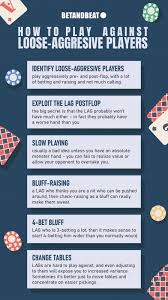Without a shadow of a doubt, the most difficult player to combat at the cash game tables or in tournaments is one who plays a loose-aggressive poker strategy and plays it well. A good loose-aggressive player, or LAG, at your table is a constant thorn in your side. Such players will frequently raise and three-bet preflop, fire more than their fair share of continuation bets, are not afraid to barrel on all three streets, and will pounce on any sign of weakness.
What is Loose-Aggressive Poker Strategy?
As its name suggests, a loose-aggressive poker strategy sees players loosen up their starting hand requirements (they play quite a lot of hands, often 30% or more that are dealt to them) and they play them aggressively (by coming out betting and raising). However, not all LAGs are created equal. Bad LAGs are often reckless and will never find a fold, but LAG players who know the nuances of how to play loose-aggressive poker well almost always know where they stand in a hand and will fold to resistance.
Loose-Aggressive Poker: Starting Hands
Some LAGs will play literally any two cards dealt to them and rely on their aggression or postflop skill to outmaneuver their opponents once the community cards come into play. If you are looking to start playing with a loose-aggressive poker strategy, it is advised to have some structure to your starting hand requirements.
We mentioned earlier than LAGs play a lot of hands, often 30% or more that they are dealt. Thirty-three percent of hands is a range that would include:
- 22-AA
- 54s+75s++
- K8o+K4s+A2o+A2s+
As you can see, 33% represents a lot of hands, which is where some of the strength of a LAG style stems from — you have a difficult time knowing if such players are strong or weak preflop and whether they are betting with a pair, set, draw, or on a bluff after the flop.
How to Combat a Loose-Aggressive Poker Strategy
You have probably gathered by now that taking on those who know how to play loose-aggressive poker can lead to stressful situations at the tables, but that is not to mean that they are unbeatable. You just need to adapt your own style to combat theirs and use their LAG style against them.
First, when playing against LAG players give more consideration to your own starting hand requirements. Finding yourself out of position against LAG players is a nightmare, but even having position on them while holding a weak hand can be equally as difficult.
A hand such as K♠8♥ may be a perfectly legitimate hand to open with from the button, but if there is a good loose-aggressive player in the big blind who has been three-betting you all session, it is probably best not to raise here as a steal because you are likely to get raised again and put yourself in a difficult spot.
Also think about using an opponent’s loose-aggressive range of starting hands against them by bluffing them. A couple of paragraphs ago we advocated slowplaying big hands preflop, yet you can also four-bet bluff a habitual three-bettor — especially if you have a tighter image — because they will give you credit for a strong hand and they are more likely to be holding something less than stellar.
Likewise, the occasional check-raise bluff on later streets can work wonders if your loose-aggressive opponent has shown to be capable of giving up on a hand when facing aggression.
Like all moves in poker, do not overuse any of the tips mentioned above. If you do, you will become much easier to read, and someone will eventually call your bluff. Once players with a solid loose-aggressive poker strategy figure out what you are trying to do against them, they will target you and make your time at the tables most uncomfortable.
Meanwhile, learn how to play a LAG style yourself and you can be the one making things less comfortable for others at the tables.
Tags
- cash game strategy
- tournament strategy
- no-limit hold’em
- loose-aggressive style
- aggression
- bluffing
- starting hand selection
- position
